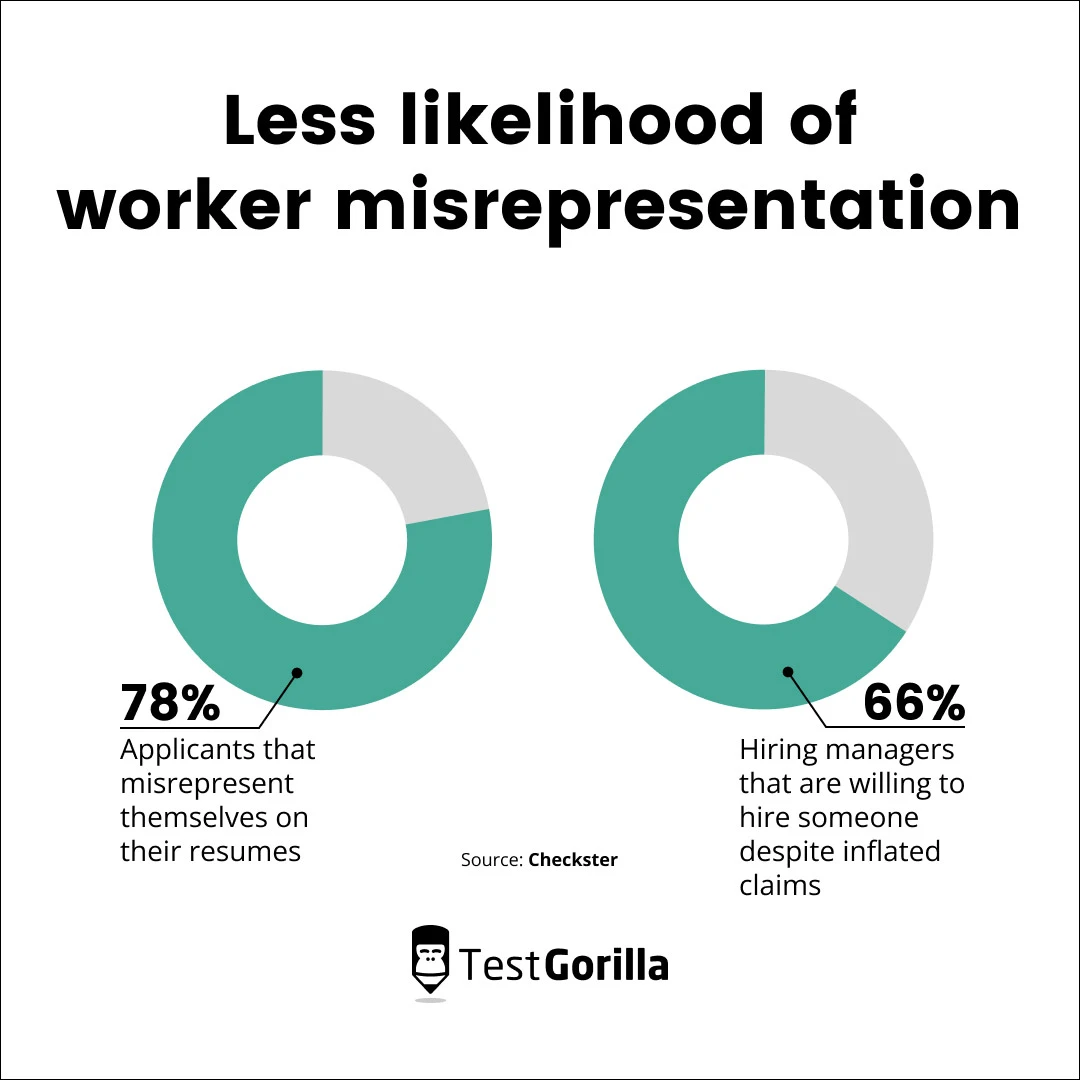Passive recruiting: How to leverage this talent acquisition strategy and secure in-demand talent
There’s outstanding talent out there, but it could be sitting at another company’s office.
“What good does that do me?” you may ask.
Many workers are on the verge of leaving their current employer for the right offer. More than 85% of Gen Z professionals would switch jobs to work for a company with a more closely aligned culture.[1]
These people could be the high-performers missing in your talent pool.
Passive recruiting isn’t one of the best talent acquisition strategies – it’s an art.
There’s more to passive recruitment than simply offering a job to employed people. You can refine this tactic to fill your talent pool, promote your employer brand, and facilitate proactive recruitment.
This blog discusses why passive recruitment is important, its top benefits, and the best practices to build your passive hiring strategy.
Table of contents
- What is passive recruiting?
- Why is passive recruitment important?
- The benefits of passive recruiting
- 6 best practices for leveraging passive recruitment to acquire top talent
- 3 examples of companies succeeding with passive recruiting as a talent acquisition strategy
- Streamline passive recruiting with skills tests
What is passive recruiting?
Passive recruiting is when hiring managers source and nurture candidates not actively looking for a job. It involves building a relationship, educating the worker about your company, and making an offer when the time is right.
Because of the job market, passive recruiting is gaining quick popularity along with other talent acquisition trends, such as candidate experience and employee wellness.
Passive recruitment usually involves nurturing a relationship with a potential worker. Building a relationship over social media platforms with potential candidates and sending over a job offer when they show interest is part of it.
However, there are other passive recruiting methods out there.
Another common way is to maintain a relationship with people until they switch from “passive” to “active” candidates and start job hunting. Then, you can extend an offer without convincing them to leave their company.
Speaking of, let’s talk about the difference between active recruiting vs. passive recruiting.
Active recruiting vs. passive recruiting
Active recruiting is the act of searching for professionals who are looking for new opportunities. On the other hand, passive recruiting is when a recruiter targets talent not searching for a new role.
Here’s a clear comparison of the two:
Active recruiting | Passive recruiting |
1. The recruiter begins the application process, posts ads for a new position, and reviews active candidates 2. The recruiter communicates with candidates who are actively looking for work, like using the #opentowork tag on LinkedIn | 1. The recruiter sources talent through other means, such as referrals or social media research 2. The recruiter gradually builds a relationship by communicating via social media or email 3. The recruiter gently promotes company values, culture, and benefits |
When a worker isn’t actively trying to join your company, you’re going to need keen passive recruiting techniques to locate and nurture them.
You’re also going to need to educate yourself on the ins and outs of sourcing passive candidates.
If you want to get started, read more in our blog on recruiting passive candidates.
Why is passive recruitment important?
Passive recruiting strategies have always existed – why wouldn’t you want top talent in your company instead of the competition?
But it has to be said that it’s become popular for several reasons.
First, the war for great talent is still raging. Companies compete for the best workers during a skills shortage, and employees aren’t shy about moving to a new organization for a better offer.
Increasingly, more workers are prioritizing their wellbeing. If your company offers them what they need, like flexible work or mental health benefits, they happily come your way.
The second reason passive recruitment is gaining traction is the rise of technology. Sourcing and nurturing potential hires was much more difficult before we had passive recruiting tools to source top talent and social media to initiate a conversation.
Technology enables fast, efficient hiring, and we’re here for it.
Passive recruiting is a key element in your people strategy, and we finally have the tools to streamline it.
Why is it a key element in your HR strategy? Let’s take a look:
Helps succession planning: Passive recruitment enables you to scour your industry for the ideal worker to fill an important role far before it’s vacated.
Fills your talent pipeline: Filling your talent pipeline with likely hires helps recruiters fill roles efficiently when they open.
Enables you to act fast: Having a pre-established relationship with a worker helps you act fast and recruit them the minute they turn active and start job hunting, giving you a leg up on the competition.
Shows people you’re an employee-focused brand: Touching base with top talent, offering helpful resources, and congratulating their wins is a great way to show you’re a people-first company.
Passive recruitment isn’t just beneficial for employers. It offers key advantages to the candidates themselves:
Improves the candidate experience
Assures workers that you’re people-minded
Offers job seekers a welcome opportunity
Taking the time to build a relationship with potential hires improves the overall candidate experience. It lets them get to know you and your company and learn about your organizational culture.
This steady nurturing makes candidates feel important and assures them you’re an employee-first brand. It tells them you saw their professional achievements and skills and knew they were a quality candidate.
Passive recruitment also benefits workers who only put up with their current company because they didn’t think there was anything out there for them.
You can give them a welcome surprise by offering them something truly special.
The benefits of passive recruiting
Passive recruitment fills your talent pipeline with prequalified candidates, reducing time-to-hire and improving overall quality.
It’s a top-tier strategy that helps you secure great new employees – so let’s look at the benefits.
Reduces time-to-hire
Taking the time to fill your talent pipeline with quality candidates speeds up your time-to-hire.
Let’s consider a common scenario. An excellent employee suddenly leaves after providing service to your company for years. Now you’re left with a vacancy, and an important one at that.
As with all open positions, you would have to write up a job description, post a job ad, and start the long process of vetting candidates to take their place.
But passive recruitment takes away the long wait.
When a crucial role opens up at your company, you can contact candidates you’ve spent time nurturing to fill positions quickly, ensuring that key roles aren’t open for too long.
Improves the quality of potential hires
Passive recruiting means contacting people who are already employed. They’re established professionals who have the skills necessary for the role they’re in.
Hiring them removes much of the guesswork and enables you to qualify candidates quickly. You can then smoothly move them into your company.
Their current capabilities, plus your onboarding best practices, mean they can get up-to-date quicker than ever.
Best of all, you can move through the hiring process without constant lingering doubts concerning bad hires.
Workers may be prequalified for the role
Some workers have prequalifications, but instead of guessing, you know for certain that they do.
If you reach out to professionals from your past hiring initiatives, you don’t have to worry about whether the person is right for the role the whole time you’re building a relationship.
You already know they are, especially if you assessed them with talent acquisition technology, like skills tests.
Hiring prequalified candidates also sidesteps educating candidates about who you are or what you do.
They not only know what you do, but they also want to get on board. We can talk about this more later.
Less likelihood of worker misrepresentation
Active job seekers are more likely to misrepresent their skills when they seek a new job. Many people want to embellish their experience, skills, and competencies to stand out and get hired.
One survey found that 78% of applicants misrepresent themselves on their resumes, and hiring managers are willing to hire someone despite inflated claims 66% of the time.[2]
The good news is that passive job seekers aren’t searching for work, so they’re much less likely to misrepresent their skills.
These people aren’t trying to get your attention or “sell themselves.” They’ve already got a job, so they’re going to be more comfortable sharing their real abilities with you.
Less competition from other companies
The threat of competition snatching away great talent is always at the back of a recruiter’s mind.
You might wonder if a candidate is considering other companies or if they are interviewing with other organizations the same week they’re going through your interview process.
Passive recruiting targets qualified candidates who aren’t blatantly on the market, making it likely that you’re the only one talking to them about new opportunities.
Even if these people have a casual eye on other opportunities, they aren’t advertising their availability or applying for jobs, so most of the competition isn’t vying for their attention.
6 best practices for leveraging passive recruitment to acquire top talent
You know why you want to target these workers with your job postings. Now, let’s review the best passive recruiting strategies you can adopt to amplify your efforts.
It isn’t as easy as just handing an application to your chosen professional, but trying tactics, like adopting skills-based hiring and boosting your employer brand, is still straightforward enough for companies of all sizes.
Passive recruitment strategies: A summary
Strategies | Description |
1. Use talent assessments to determine what you want in passive professionals | - Use talent assessments to conduct a skills gap analysis - Take the results and build a solid ideal candidate profile |
2. Approach people from your previous hiring initiatives | - Use your skills test database from previous hiring initiatives to organize and find top talent - Consider these candidates because of their prequalifications and awareness of your brand |
3. Strengthen your employer branding | - Promote your values and show workers what you can offer them - Display your learning opportunities, flexible work policy, and inclusive culture |
4. Find the right way to source passive talent | - Encourage employee referrals to gain access to high-quality passive workers - Hit social media and find passive talent through informative content |
5. Use engagement tactics | - Create a recruitment marketing campaign to engage people with newsletters and posts - Make workers aware of your culture, practices, policies, and benefits |
6. Get to know your potential hires | - Take time to get to know each passive worker and learn their preferences - Offer them a role they’ve always wanted |
1. Use talent assessments to determine what you want in passive professionals
Passive recruiting is a long process where you must dedicate your time and effort to a handful of professionals.
You want a solid grasp of the skills needed for the role you’re filling.
Going that far in the recruitment process only to discover you didn’t know a key competency is detrimental to effort and budget. But there’s an effective way to know exactly what you want.
A skills gap analysis enables you to evaluate your current workforce and determine your needed skills.
Using talent assessments to gather this information makes the process data-driven and accurate.
Here’s a quick step-by-step on using skills tests to conduct a skills gap analysis:
Determine your main goals
Evaluate individuals and teams with talent assessments
Analyze the results to discover missing skills
Create a plan to bridge the gap
This data driven recruiting method enables you to inform your process with more than guesswork.
With this information, you can create a detailed and accurate ideal candidate profile to assist your passive sourcing and strategic workforce planning.
Once you’ve secured a potential hire, you can use the same tests to evaluate their skills to match them to the position perfectly.
2. Approach people from your previous hiring initiatives
Previous hiring efforts are a goldmine of talented individuals who already know your brand and even took a shot at one of your roles.
These people weren’t 100% successful and didn’t get the position then, but that doesn’t necessarily mean they are not qualified.
Sometimes, you don’t choose a candidate because they only lack a few key skills.
Other times, it’s because you had a high volume of qualified talent and had to choose someone who barely beat the competition.
Whichever it was, past hiring efforts are an excellent place to source prequalified candidates who are already aware of your company.
Using talent assessment tests is even easier because all your previous potential hires are stored in a database for you to review.
Here, you can see that Sarah Jackson scored the highest, but Matthew Donovan isn’t far behind. Matthew is an excellent passive professional, no matter where he’s working now.
3. Strengthen your employer branding
Even employees who are quite comfortable at their current workplace could switch to a stellar company with strong employer branding.
Employer branding is how employees and potential hires view your company’s reputation.
Strong employer branding shows the value you bring as an employer, including:
Offering flexibility in the workplace
Promoting inclusivity and psychological safety
Providing learning and development opportunities
The last point alone makes you stand out to prospective hires. Research shows that 48% of workers would switch to a new job if provided learning opportunities.
Employer branding is more than just competitive compensation and benefits. It’s how you treat your people and the support you provide.
And it could just be the dealbreaker to passive talent considering an offer.
For more insights on this topic, read our full guide on employer branding.
4. Find the right way to source passive talent
Passive sourcing in recruitment can be tricky, so it’s best to lay out your options ahead of time.
The best place to start your passive recruitment efforts is with your existing network.
Asking your existing employees if they know anyone with top credentials is one strategy that helps you lay the groundwork for engaging passive talent.
It’s a faster way to make the right contacts, and it’s also more reliable. One study found that 78% of recruiters say they find the best candidates via referrals.[3]
Creating an employee referral program helps make this process more natural. It standardizes it and makes it smooth for employees to participate.
Social media is a great way to facilitate employee referrals. Employees can make positive posts about working for your company and encourage their network to check out your website and job board.
But social media is also ideal for your sourcing. Making connections over social media helps you spread the word about your organization, and it’s an easy way to stay in contact with top talent.
5. Use engagement tactics
Passive recruitment needs to focus on engaging your potential hires.
It’s still important with active recruitment, but engagement isn’t a top priority because those people are actively looking for work. Active talent already wants the role and is researching your company.
But with passive recruiting, you want workers to engage with your hiring tactics.
You want to excite, entice, and get them interested in your organization.
A simple way to do this is through recruitment marketing. Creating a recruitment campaign puts your company in front of more eyes and educates people on your good company culture, practices, policies, and benefits.
You can combine this practice with recruiting automation to streamline the process further.
Through these passive recruiting techniques, you put your company on the doorstep of your passive workers, but you are doing it subtly through newsletters and social posts.
Subtlety is key in passive recruitment.
6. Get to know your potential hires
When you’re nurturing potential future employees, you aren’t just convincing them to join you. You’re also steadily learning about them.
Listen to them and remember the roles they’re interested in, the kind of work environment they prefer, and the skills they want to develop.
You can craft a specific offer for them that’s highly relevant, making it harder for them to say “no.”
It also gives them a clear picture of what it’s like to work with you. It shows that you care about them and their preferences.
Showing them upfront that you want to get to know them shows that you aren’t likely to saddle them with work they find unsatisfying – which could well be where they are in their current job.
Building a slow, two-way relationship is a crucial part of candidate nurturing. It shows passive workers that you care about who they are, not just the numbers they score for the competition.
3 examples of companies succeeding with passive recruiting as a talent acquisition strategy
Here’s a quick look at three companies that used passive recruitment strategies to the fullest and secured excellent new hires.
Companies successfully using passive recruitment: A summary
Organization | Description |
Wizz Air | Used recruitment marketing to engage and entice passive talent |
Cummins | Leveraged AI tools to source passive workers and find niche skills |
Mastertech | Took advantage of social media to compete in a difficult industry |
Wizz Air
Wizz Air, a Central European airline, held a massive recruitment marketing campaign centered on displaying its people and culture.
This campaign occurred on social media, primarily YouTube and Instagram, and consisted of current employees telling their stories using the hashtag “#IamWIZZcrew.”
These videos educated passive talent in company culture and gave them career tips directly from current employees.
This strategy is excellent because it encompasses several of our favorite passive recruitment methods, such as:
Using current employees
Engaging workers with informative content
Educating workers on company culture and practices
This campaign also displays how satisfied the airline’s employees are with their work to potential hires. It shows them in their element, enjoying work and encouraging others to join them.[4]
Cummins
Cummins, a technology leader, needed to fill important roles: a cybersecurity analyst and a lead IT applications analyst. These hard-to-fill positions require niche skills.
Its team turned to passive recruitment to fill these tricky roles.
The team used AI tools and built a talent pool of likely hires. They enabled the AI to source passive workers, then used the human team to review the results and offer feedback to the software.
The business showed a great AI best practice here.
AI in talent acquisition is convenient, but you should always combine it with a human touch for the best results.
Speaking of results: What were the results of the company’s passive recruiting techniques?
The company sent select passive prospects customized emails to engage and excite them, leading to an open rate of 60% versus the industry average of 32%.
This strategy helped Cummins fill three niche positions in only two months.[5]
Mastertech
Mastertech, a heating, ventilation, and air conditioning company, struggled to fill positions.
It had a sluggish recruitment process and operated in the fiercely competitive Dublin market. Local job boards were flooded with similar roles, which made it even worse.
To solve this issue, the business’s recruiters used LinkedIn to directly reach out to likely hires and encourage them to apply.
This strategy vastly improved the company’s hiring process. Here are the results:
Resume-to-interview ratio was four to one
Resume-to-placement ratio was seven to one
Interview-to-placement ratio was two to one
The company loved the results and wants to continue this type of strategy. It helped Mastertech not only stay afloat in a difficult industry but thrive.[6]
Streamline passive recruiting with skills tests
Competition could be fierce, but passive talent acquisition strategies help you stand out and secure excellent new workers.
Even if workers aren’t searching for new opportunities, you could be able to offer them something special and have them make the switch.
Try pushing your goals with skills tests to create an accurate candidate profile, then use great sourcing methods like employee referrals or social media to connect with them.
If you’d like to dive more deeply into this topic, read our blog on social media recruiting.
If our talent assessments have piqued your curiosity, browse our test library to plan your skills gap analysis.
Sources
Kiderlin, Sophie. (April 20, 2023). "Overwhelming majority of Gen Z workers would quit their jobs over company values, LinkedIn data says". CNBC. Retrieved August 22, 2023. https://www.cnbc.com/2023/04/20/majority-of-gen-z-would-quit-their-jobs-over-company-values-linkedin.html
"Hiring Charlatans?". Checkster. Retrieved August 22nd, 2023. https://www.checkster.com/are_you_hiring_charlatans
"The Jobvite Recruiter Nation Survey". (2015). Jobvite. Retrieved August 22, 2023. https://www.jobvite.com/wp-content/uploads/2015/09/jobvite_recruiter_nation_2015.pdf
Noeth, Bart. (September 29, 2017). "Wizz Air has launched the biggest recruitment campaign in its history". Aviation24. Retrieved August 22, 2023. https://www.aviation24.be/airlines/wizz-air/has-launched-its-biggest-recruitment-campaign-in-its-history/
"Cummins Unlocks the Power of Sourcing". Visage. Retrieved August 22, 2023. https://www.visage.jobs/customer/cummins-sourcing-case-study/
"Mastertech Case Study". Mastertech. Retrieved August 22, 2023. https://rentarecruiter.com/case-studies/outsource-talent-as-a-service-mastertech/
Related posts
Hire the best candidates with TestGorilla
Create pre-employment assessments in minutes to screen candidates, save time, and hire the best talent.
Latest posts
The best advice in pre-employment testing, in your inbox.
No spam. Unsubscribe at any time.

Hire the best. No bias. No stress.
Our screening tests identify the best candidates and make your hiring decisions faster, easier, and bias-free.
Free resources
This checklist covers key features you should look for when choosing a skills testing platform
This resource will help you develop an onboarding checklist for new hires.
How to assess your candidates' attention to detail.
Learn how to get human resources certified through HRCI or SHRM.
Learn how you can improve the level of talent at your company.
Learn how CapitalT reduced hiring bias with online skills assessments.
Learn how to make the resume process more efficient and more effective.
Improve your hiring strategy with these 7 critical recruitment metrics.
Learn how Sukhi decreased time spent reviewing resumes by 83%!
Hire more efficiently with these hacks that 99% of recruiters aren't using.
Make a business case for diversity and inclusion initiatives with this data.


















